From Habitat magazine - issue 24
As Resene turns 70 we look at the colours that we've loved to use in our homes since the 1950s, and reinvent them for today.
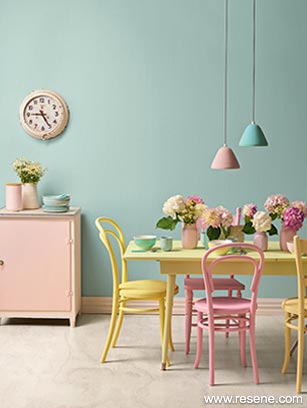
The 1950s was a time of optimism after the grim war years. There were new materials like Formica®, vinyl, chrome, labour-saving devices and lots of hopeful fresh colour.
Pastels were in – pretty pinks, minty greens, pale blue, lemon and mauve. Use these colours today for this dreamy dining setting with a vintage vibe. The wall is Resene SpaceCote Low Sheen in Resene Nebula, the table is Resene Geneva, while the mismatched chairs are Resene Princess (pink), Resene Moonbeam (yellow) and Resene Melting Moment. There's a sideboard in Resene Bianca and Resene Pink Terrace, with vases in Resene Pink Lace, Resene Alluring (mauve) and Resene Sea Nymph. The floor is finished in Resene Colorwood Whitewash and the skirting is Resene Pink Terrace.
Props 1950s: Concrete Pendants in Blush and Mint, from Junk & Disorderly. Sorrento Rice Cutlery Set in Mint, Rice Ceramic Embossed Jug, Rice Ceramic Large White Jug, from Allium Interiors. Impressions Bowls, Sorrento Cuddle Mug, Sorrento Side Plates, Sorrento Serving Bowls, Willow Canister in Blush, and in Lemon, from Freedom Furniture.
The 1960s was groovy baby – an exciting, turbulent era full of social change, new music and the mini skirt. The colours of the 60s were sharp orange, intense teal, banana yellow, cyan blue and red. Bold, psychedelic colours.
Use those intense shades today, in transitional areas like halls where you see them fleetingly. Add a simple curvy vase and a tropical touch with a monstera leaf. The wall here is Resene Hullabaloo, the hall table and shelf are Resene Trinidad, the boxes are Resene Gorse and the box lids, frame and vase are Resene Candy Floss.
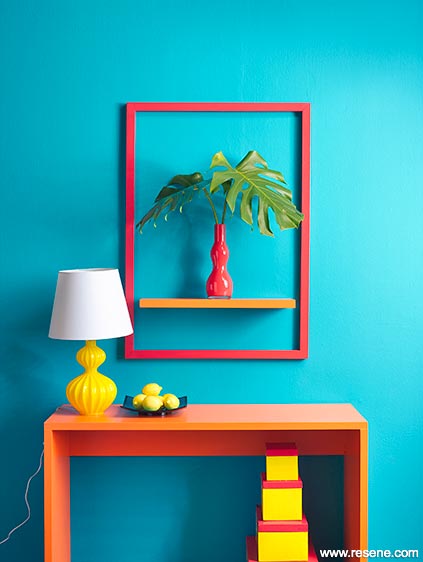
1960's look
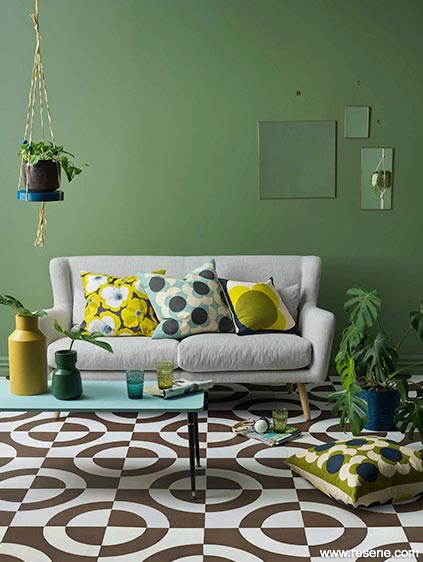
1970's look
The 1970s was an era of hippy culture, mellow homespun looks, shagpile carpets and the lava lamp. Colours became earthier than the pretty pastels and saturated brights of the two previous decades. There were bronzed greens, warm tan, burnt orange and chocolate brown.
Today we can use those colours in this hippy-inspired living room, with a dramatic stencilled floor in Resene Lignite (brown) and Resene Quarter Cararra. The wall is Resene Paddock, the coffee table is Resene Unwind and the basket and hanging shelf are Resene Barometer. The vases are in Resene Intrepid (mustard) and Resene Seaweed.
Props 1970s: Nelly two-seater sofa, from Danske Mobler. Odin Copper Mirrors, Orla Kiely High Ball Glasses, Orla Kiely Big Spot Shadow Flower Cushions, Orla Kiely Cushion, from Allium Interiors. Floral Cushion, from Republic Home. Rajasthani Wooden Pot (in hanging shelf), and Philodendron Cordatum Plant, Broste Anet vase, and String of Pearls plant from Indie Home Collective.
The 1980s was a decade of two halves – the hedonistic brash years before the 1987 stock market crash, followed by a more sombre mood post-crash. Colours of the 80s interiors were nurturing apricots, nude pinks, pale greys along with black and white, and shots of bold colour.
Who would have thought that pink and grey could look so good again? This soothing living room uses palest shades for a whimsical elegant look. The walls are Resene Rakaia, the trims are Resene Alabaster, the floor is blonded with Resene Colorwood Rock Salt, the shelving unit is Resene Sweet Spot (pink) and Resene Seashell. The short grey vase on the top shelf is Resene Tapa and the pale urn on the bottom shelf is Resene Rolling Fog. The side table is in Resene Reservoir.
Props 1980s: Joe Armchair in Stone, from St Clements. Clovis Glass Vase, from Indie Home Collective. Blom Mint Fluted Vase, Small Vase, and ET Lamp Shade, all from Allium Interiors. Pink Velvet Cushion, from Madder & Rouge. Charade Vessel, from Freedom Furniture. Jas Pink Vase, from Allium Interiors.
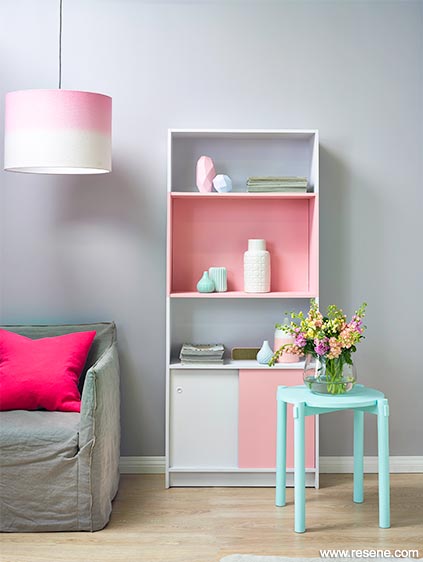
1980's look
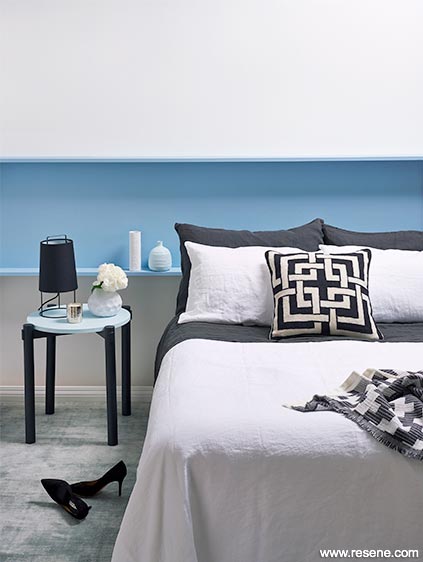
1990's look
The 1990sturned its back on excess; it was a decade for minimalism and simplicity. Our eco consciousness began to grow and the internet took off. Colours were pared back, neutral and soothing – no-nonsense blacks, clean whites, zen greens, icy aquas and nautical blues.
Today we can use those colours in this ultra-calming bedroom, with walls in Resene Black White and a bedside table in Resene All Black and Resene Cut Glass. A slice of bold ice blue Resene Frozen appears in the recessed headboard and shelf while the vases are in Resene Quarter Alabaster, Resene White Thunder and Resene Cut Glass.
Props 1990s: Bedouin Societe Queen Duvet, Pillowcase Pair (black or white), from Indie Home Collective. Décor Essence Floor Rug, from Allium Interiors. Black and White Cushion, from Republic Home. Domino Throw in Black, Dacey Table Lamp, and Amina Candle, from Freedom Furniture.
The new millenium came and the world's computers didn't fail. Technology advanced, the green movement grew, and we yearned to feel safe after the terror of 9/11.
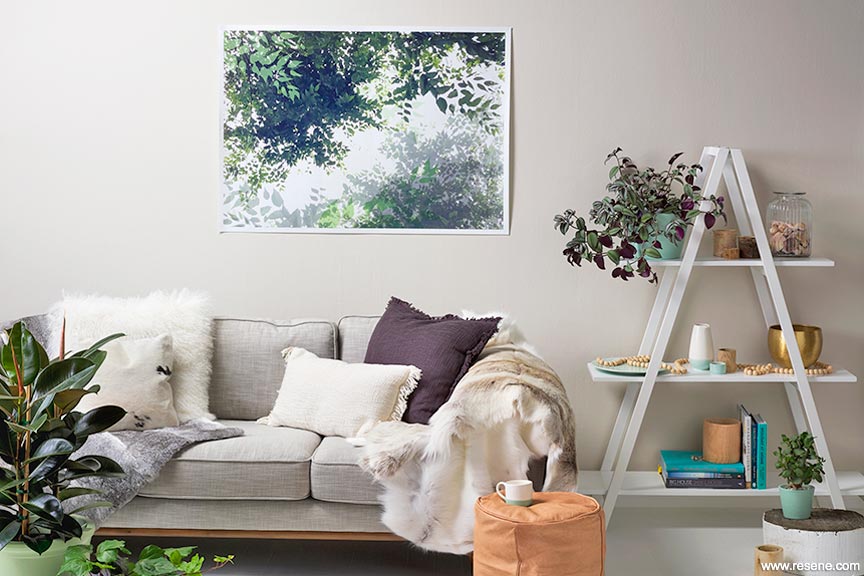
For Resene, this decade was all about tea – Resene Tea sold in the bucket-load. This safe cocooning beige was celebrated as an incredibly versatile colour and was joined by cool whites, botanic greens, silver and moody taupes.
Today this living room has a Scandi vibe, with animal skin rugs and cushions, house plants and a wall in Resene Half Tea. The floor and tree stump are Resene Sea Fog while the pots are Resene Tax Break (bottom left corner), and Resene Gum Leaf (on shelf and stump).
Props 2000s: Dahlia Sofa, and A-frame M3 Bookshelf, from Freedom Furniture. Tibetan Lamb Cushion, Cowhide Cushion, Rabbit Throw, and Reindeer Hide, from Lapco. Fringed Cushion, Tan Pouf, Decorative Beads, Wooden Candles (set of 5), from Good Thing. Dada Lumbar Cushion Cover (white), and Gava Planter (bronze), from Citta Design. Looking Up Print, Mavis Jug, Budgie Cup, Doris Plate, Archie Ramekin, by Amber Armitage.
Stockists: Allium Interiors, www.alliuminteriors.co.nz, 09 534 4242. Amber Armitage, www.amber-armitage.com. Citta Design, www.cittadesign.com. Danske Mobler, www.danskemobler.co.nz. Freedom, www.freedomfurniture.co.nz, 0800 373 336. Good Thing, www.goodthing.co.nz, 09 815 2052. Indie Home Collective, www.indiehomecollective.com, 09 524 6971. Junk & Disorderly, www.junkndisorderly.co.nz, 09 480 9010. Lapco, www.lapco.co.nz, ph 09 302 1350. Madder & Rouge, www.madderandrouge.co.nz, 09 522 1062. Republic Home, www.republichome.com, ph 09 361 1137. St Clements, www.stclements.co.nz, 09 336 1304.
One of the country's largest family-owned companies, Resene, turns 70 this year. Resene is a pioneering company, producing eco-friendly paints and fashion colours way ahead of its time.
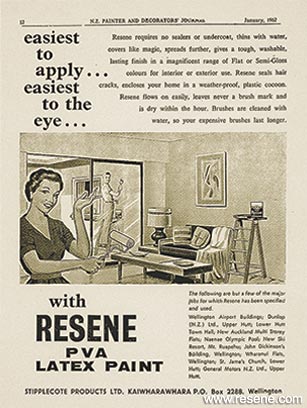
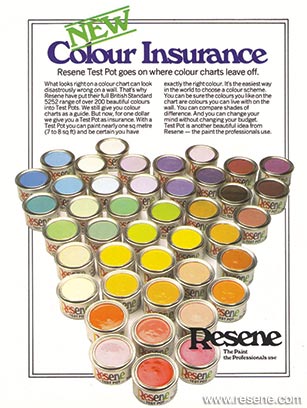
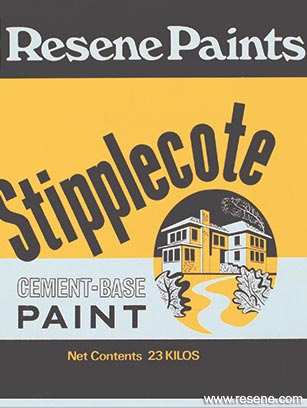
1946: Builder Ted Nightingale needs an alkali-resistant paint to cover his concrete buildings. There is nothing available so in typical Kiwi style he develops his own – in a cement mixer in his Wellington garage! In response to demand from other builders, Ted starts producing his paint commercially under the brand name Stipplecote.
1951: Ted launches the first waterborne paint in Australasia under the brand name Resene – a name derived from the main ingredient of paint, resin. Waterborne paint has a very slow start. People are nervous of the new technology, thinking that a waterborne paint will just wash off.
1952: The company is registered under the name Stipplecote Products Ltd.
1960s: The company's perseverance and intense marketing of waterborne paints, including shop window demonstrations, finally starts to pay off as waterborne paints are accepted more widely.
The company removes lead from its decorative paints to create a more environmentally friendly product, a move that is well ahead of its time.
1970s: In 1972, Ted's son Tony takes over operation of the company. The company name is changed to Resene Paints Ltd in 1977 and its factory space gets bigger and better. A radical step is made to the way Resene paint is sold. Instead of Resene being just a manufacturer and supplier, it decides to side-step traditional sales outlets and set up its own regional branches selling direct to painters and architects. This is a huge gamble.
In 1975, Resene opens the first of its series of retail stores – the Resene ColorShops – almost by accident when Tony buys a wallpaper store. The stores were overwhelmingly successful.
1990s: Resene joins the Environmental Choice programme. The company introduces waterborne enamels, a friendlier alternative to solventborne versions. Tony's son Nick takes over as general manager in the late 1990s, then becomes managing director a few years later. Resene also expands in to Australia.
2000s: Resene launches the PaintWise recycling and recovery programme to deal with unused and unwanted paint and containers. Much paint is donated to community organisations and used to cover graffiti.
Resene has built a reputation as a colour leader:
In 1969 Resene set up a new system of colour, the British Standard Specification colour range (BS2660 range), which provided a range of strong colours at a time when decorators were used to pastel colours. The launch of the BS5252 colour range in 1976 as a decorative paint collection was a world first.
Resene pioneered the development of coloured paintbases, where previously only white was used.
Resene was also the first company to offer a full range of testpots in New Zealand in 1981.
In 1985, the Total Colour Multi-Finish System was launched. Combining an extensive range of colours with interlinked tinting systems for both interior and exterior, the flexibility and adaptability of this colour system was welcomed with open arms by specifiers and retail customers alike.
•Resene delivered virtual painting technology into thousands of homes with the launch of Resene EzyPaint in 1999.
In 1999, the first of the Resene fashion fandecks, The Range 2000,was released showcasing fashion colours for the coming years. Resene also launched the hugely popular The Range Whites & Neutrals in 2003.
We're often asked how ColorShops got their name. When the first ColorShop was opened in Wellington in the 1970s, Tony Nightingale (son of founder Ted and father of Nick who runs Resene today) had to come up with a name for the stores. He decided on 'ColorShop' rather than 'ColourShop' because it looked better (more evenly balanced without the 'u') and would be unique. The capital 'S' in the middle also makes it more unique. Resene spells 'colour' correctly for normal colour charts and articles. Tony had a huge impact on Resene's history, taking the company from a very small business to a nationwide business and then one that started selling overseas. Tony's spelling of the name 'ColorShop' has been retained in his memory.
styling: 1960s by Megan Harrison-Turner, 2000s by Amber Armitage, all others by Claudia Kozub
pictures: Melanie Jenkins
Search habitat magazine stories
Printed copies of habitat highlights are available from late March 2024 at Resene ColorShops and resellers, while stocks last. You can view back issues of habitat magazine online.
Specifiers:
If you have an idea, project or story that you think would suit habitat, we’d love to hear from you. Please drop us an email with your details and include photos if submitting a project.
Sign up for a DIY card and Save! Australia | New Zealand